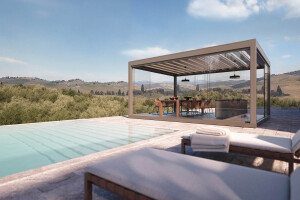Introduction
Arcadia Nursery was created to provide early-years education for children of University staff, students and the general public; catering for up to 113 children aged from 6 weeks to five years. The building brings together two existing University nursery facilities, previously at George Square and Dalkeith Road,into one purpose-built facility with extensive outdoor play area.
Concepts
Working with the two nursery managers, we identified the issues with the existing nursery buildings – disconnected spaces, lack of connection to outdoors, no opportunities for the children to come together in one space, difficultly settling children when changing age groups, and the financial strain of over-staffing due to small rooms and remote children’s WCs and baby change. The solution was to consider the new nursery as a free-flowing series of interconnected spaces that could be opened-up or closed-off to suit the activities of the day, with the focus not solely being one playroom per age group, but a series of additional spaces such as shared messy and art rooms, a children’s kitchen, raised cosy mezzanine spaces for quieter times, and a music and reading room, which are all connected at the heart of the building with a flexible welcome and circulation space, used for many functions including dining and coat storage.
The nursery managers were keen to work by the ‘free-play’ concept, this helps develop children’s confidence, independence and creativity by encouraging them to choose the activities they would like to participate in, or whether they would like to be inside or outside, rather than the day being dictated to them. The layout of the nursery has been designed to facilitate this, whilst ensuring the children are safe and easily supervised.
Age groups are encouraged to mix and not be confined to set rooms throughout the day, this reflects family groupings and allows siblings to spend time together whilst at nursery. This also eases the transition between age groups as children gradually become familiar with all the spaces, staff and children within the nursery.
Externally each age group’s playroom is clearly identifiable as a welcoming, contemporary domestic form which creates a sense of belonging and ownership for each age group. These three pavilions are then linked together by a single storey building, with large rooflight with views up to the tree canopy above. The desire to respect the façade of the adjacent listed Joseph Black chemistry building, led to a more compact footprint with raised mezzanines for the children and a first floor area for offices, staff and family room.
Accommodation
On entering the building direct views of the garden space are seen through the building – encouraging children to want to explore. A welcoming reception leads through to a flexible central space with an open kitchen to the rear to give children the ability to watch the cooks preparing food, with a smaller children’s kitchen providing a division and allowing the children to prepare food, including their home grown produce.
This flexible central space connects thethree playrooms for age groups 0-2, 2-3 and 3-5 with associated baby change and WC spaces incorporated within each playroom. Large sliding doors also interconnectthe playrooms through a shared creative and messy playspace, which allows children of differing ages to interact with one another. The babies’ room is a cosy, domestic height single storey, the 2-3 and 3-5 year rooms are taller, with raised mezzanine spaces to provide variety in spatial experience; rooflights sit above these raised areas providing views of the sky and the surrounding tree canopies whilst also allowing daylight to flood the playrooms. All the playrooms have large glazed doors which open the space out into the garden,enabling children tomove freely in and out, with a covered terrace providing a transitional space between inside and outside.
On the first floor an additional room is incorporated for use by small groups of children participating in activities such as music, reading and IT. The adult accommodation comprises an office, family room and a staff room which overlooks the garden.
Sustainability
Along with a requirement to achieve Breeam Excellent, the client was keen from the outset to create a highly sustainable building. We also felt the building’s use leant itself as an educational tool in its own right, to teach children about the varying aspects of approaching life in a sustainable manner. It was also of foremost importance that a healthy, calm environment was created for the children. The Cross-Laminated Timber (CLT) structure provided the perfect combination of creating a warm, tactile interior, whilst also using a natural, sustainable product that could structurally achieve the clear roof volumes required to ensure the mezzanines spaces were not compromised.
The specification of all materials was carefully considered, with materials being chosen that are renewable, have low embodied energy and a minimal carbon footprint, whilst also creating a vapour-open, breathable building fabric with high air-tightness. This ensured that a high indoor air quality was achieved by minimising or eliminating products which emit low level toxicity. The design stage Breeam assessment achieved a high score of 82.2%, with material and pollution sections achieving a 100% score. The building’s prime energy source is provided by the University Combined Heat and Power network.
Landscape
The outdoor space is considered as another ‘playroom’ for the nursery, with it being used every day by all age groups to encourage physical activity and engagement with nature.
The garden is divided into three distinct zones. The ‘enclosed’ garden is directly accessed from the nursery building and allowsthe children to spill-out from the playrooms, with a covered terrace providing an intermediate space, allowing outdoor play in blazing sunshine or pouring rain. Grass steps, a bubble bridge, stacking boxes, a water pump, raised vegetable planters, a slide, aclimbing rope, stepping stones and a potting shed are just a few of the many features intended to encourage ‘open-ended’ creative play.
Access to the wider landscaped area is via a secure gate, leading to a raised timber walkway providing a ‘journey’ through the trees, which opens up to more adventurous play for the older children, with a rope bridge, play trees, log ladders and sand pit. Continuing through this space leads to the final meadow zone,a space where the grass is allowed to grow long, meadow flowers flourish, birds and insects are watched and found and earth mounds provide activity for even the youngest children. A willow arbour provides an intimate picnic space, for the children to refuel from their journey to the bottom of their garden.
















































